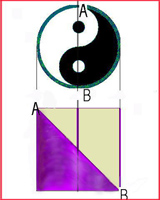|
Consider a cylinder having the two major halves of the Yin-yang symbol as the profile of two moulded pieces of differently coloured woods. Allow one of these pieces to be obliquely cut from A to B as in the illustration. What percentage by volume of the whole cylinder do each of these two parts represent? The lower part of the illustration attempts to portray a receding void on the left and having cylindrical dimensions against a similar protuberance on the right, and of the same scale. | 
|
 |
All about flooble | fun stuff | Get a free chatterbox | Free JavaScript | Avatars |


